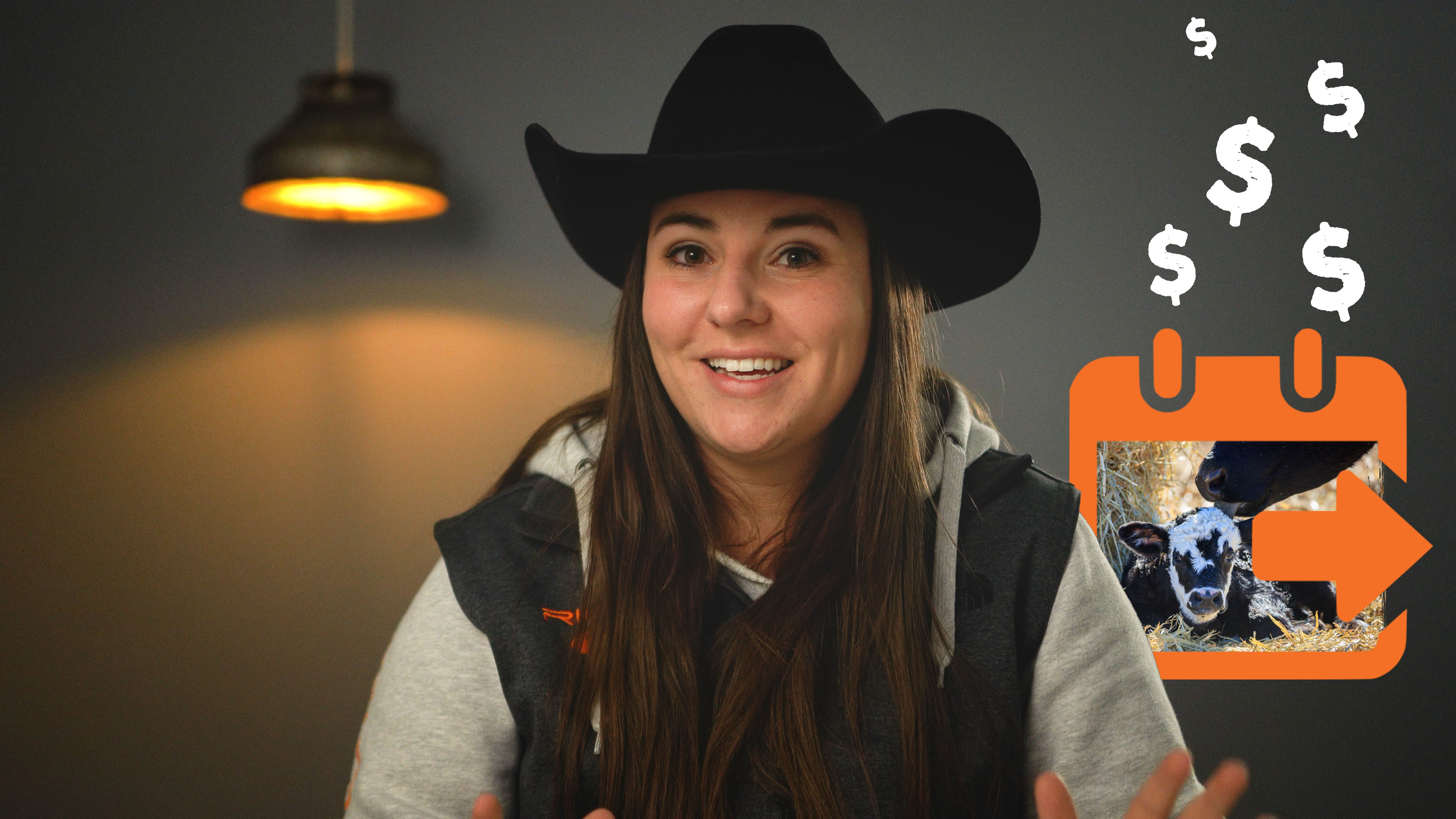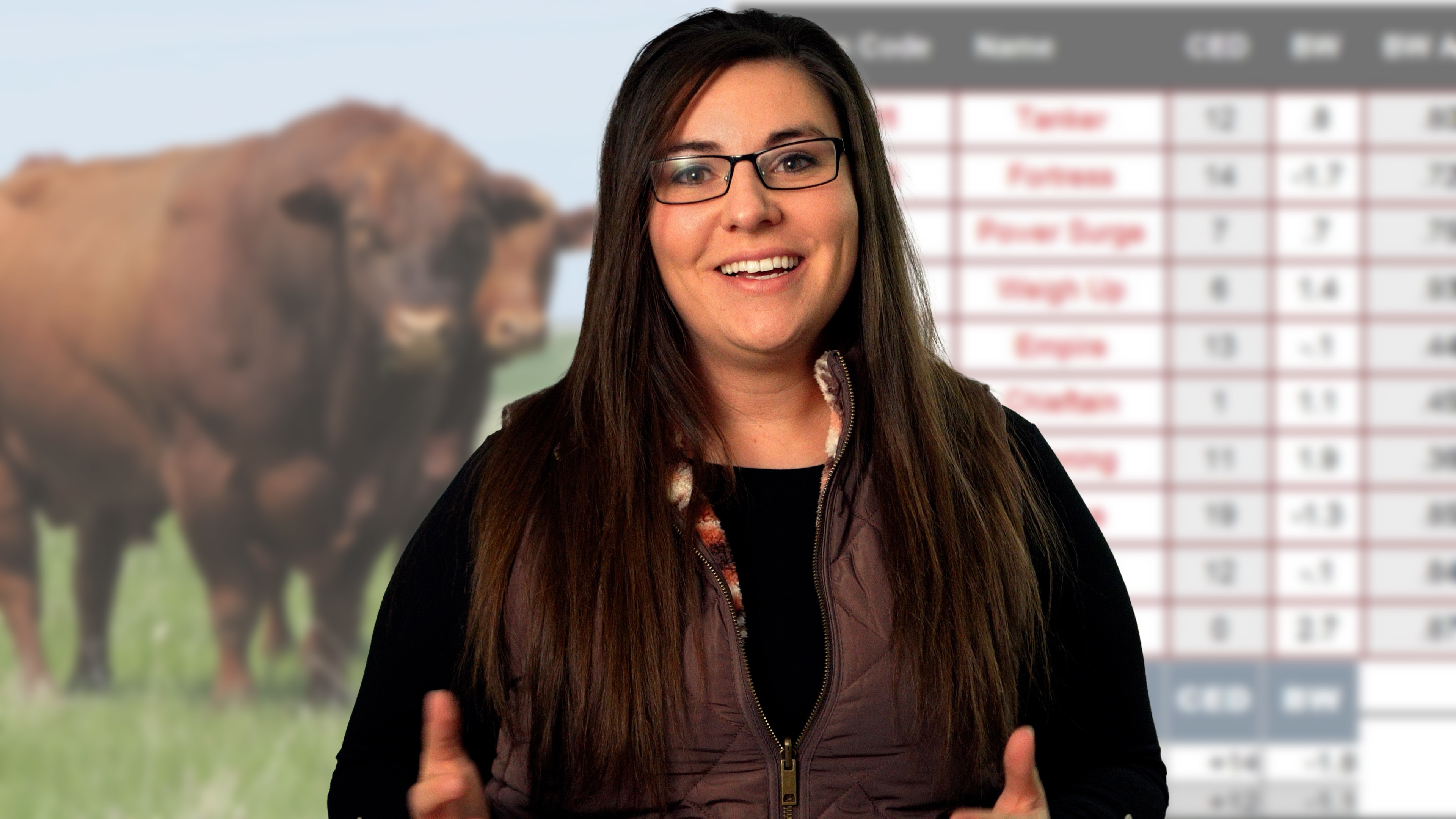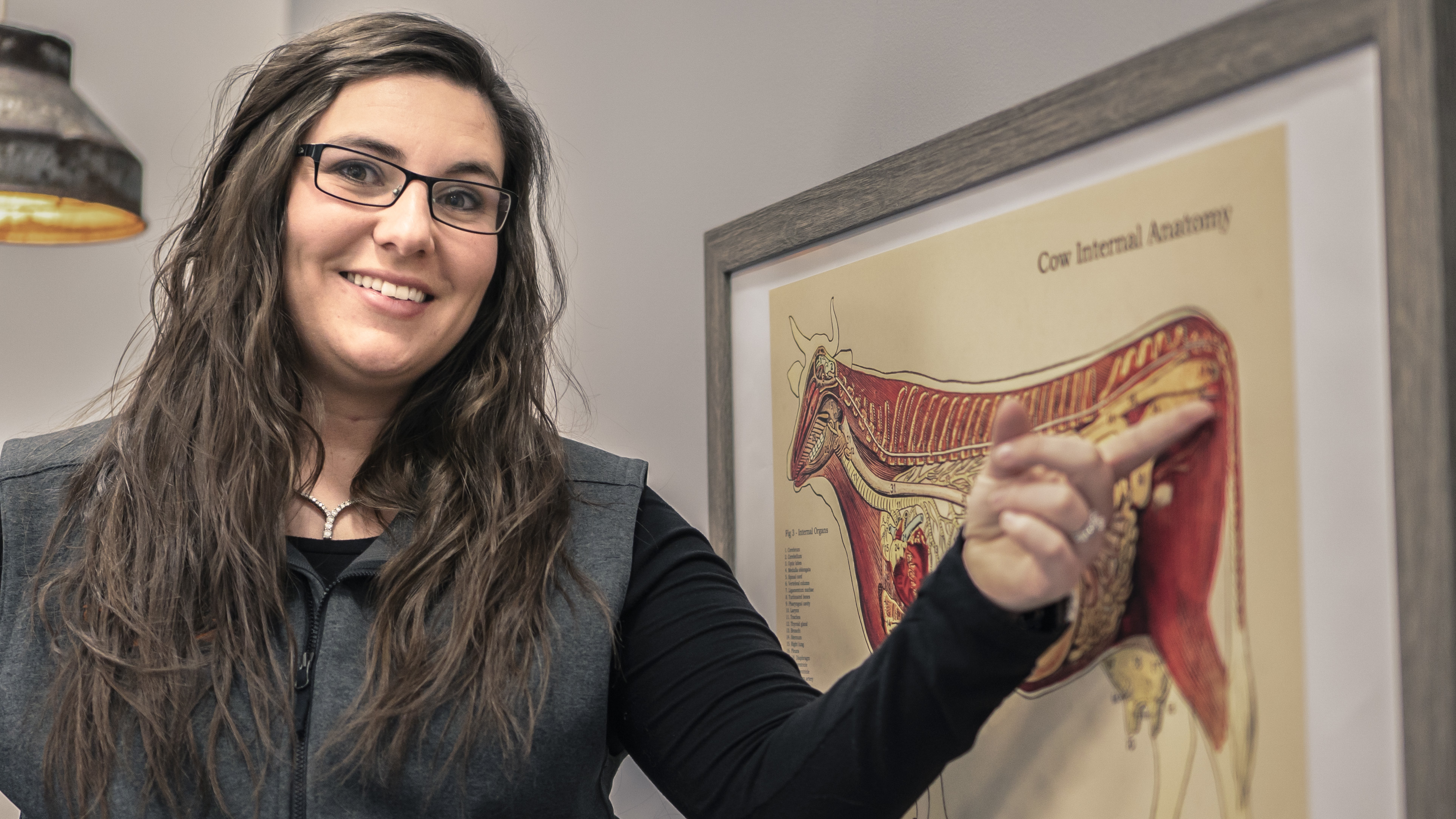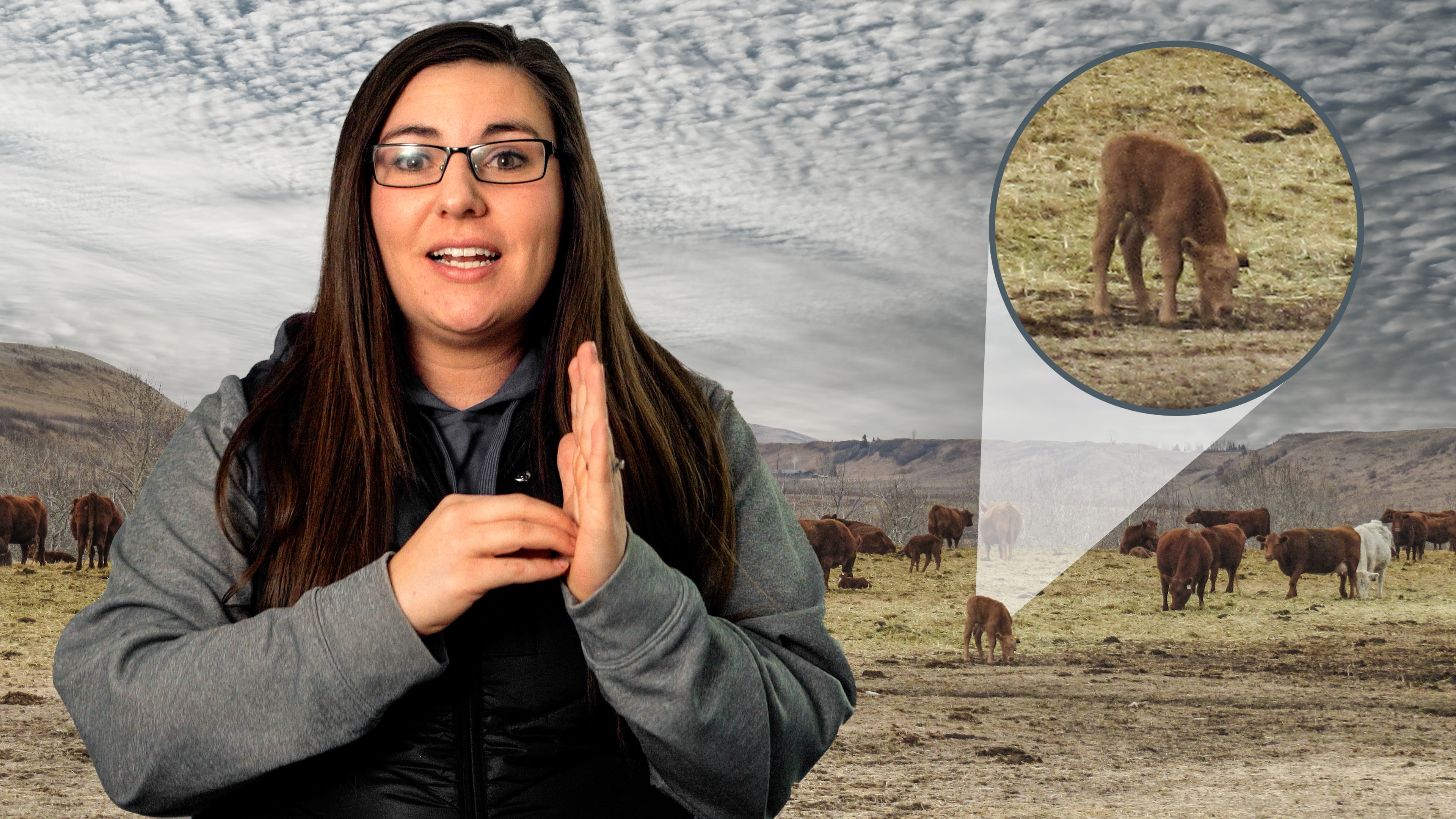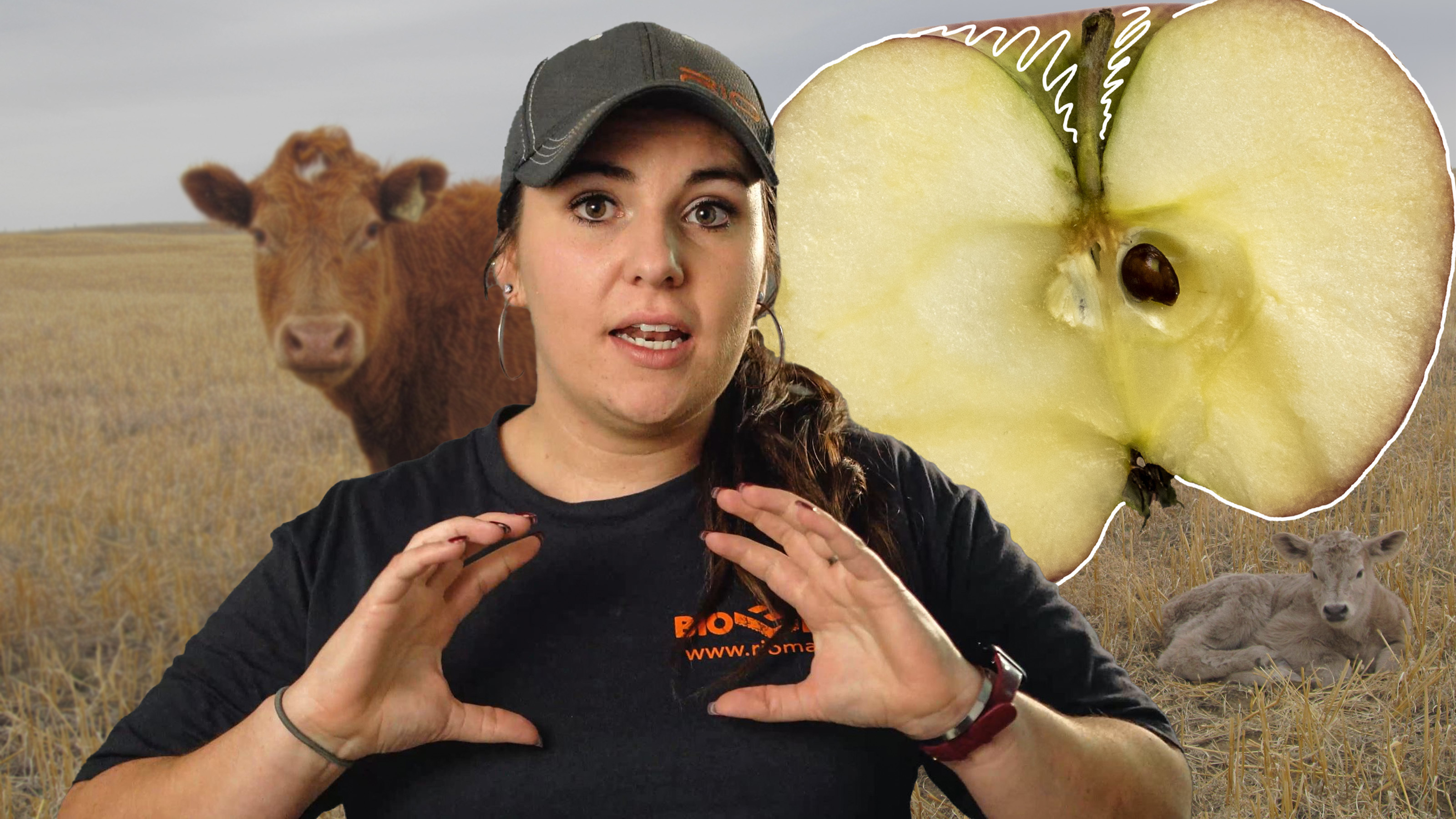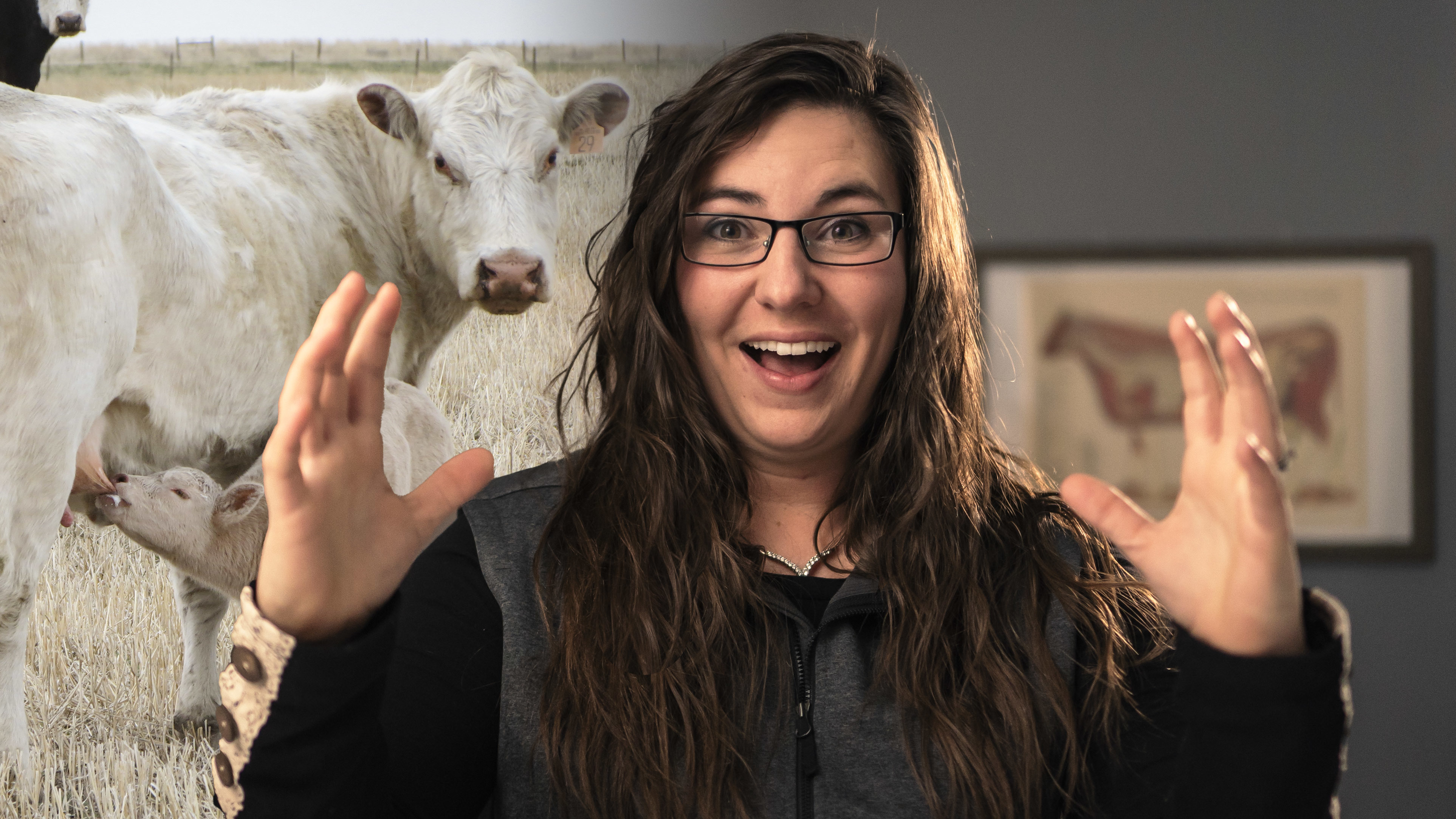Last updated on March 9th, 2022 at 10:04 am

TIPS FOR A SUCCESSFUL CALVING SEASON
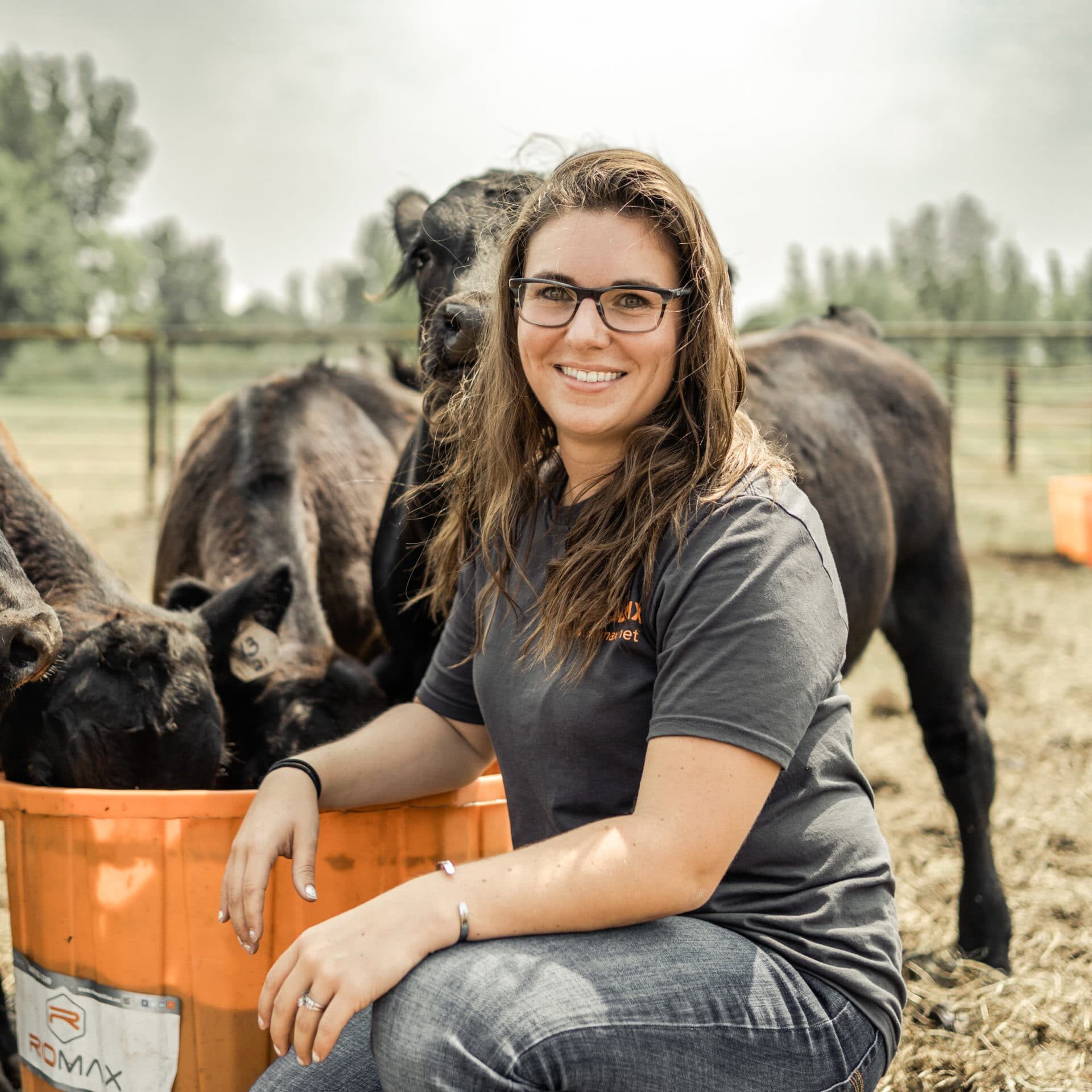
Meet Ashley Kettner!
Ashley and her husband are the 6th generation to take over his family ranch! Her focus is the same as any rancher - getting higher conception rates, tightening up calving windows, getting more marketable beef on the calves, minimal health concerns, and of course do it all cost effectively!
Chapter 1
Calving Date
Does your ranching operation calve out in the spring? The fall? Maybe somewhere in between? You’ve probably been ranching for multiple years, and may have a good reason for calving at the time you do. But what if re-analyzing your calving date could prove to be helpful, easier, and maybe even more profitable? What if you could boost calving performance, simply by changing your calving date?
There are a couple of initial questions to ask yourself.
- Where are you located geographically?
- What month do you plan to calve in currently?
- What are the weather conditions like where you live at your calving date?
If you live in the Midwest, or even out west further in Montana, Wyoming, or Colorado, you probably deal with heavy snow, below freezing temps, and high winds. It may seem normal; these are issues you just have to deal with during calving. But have you ever wondered what it would be like if you didn’t have to worry about these environmental facors?
Cold weather and precipitation are likely to invite calf sickness and other calf health, strength, and growth issues when they hit the ground. Death loss is likely higher in environments with harsh weather conditions.
The South may not experience the cold as much, but it doesn’t mean they don’t have their own environmental factors to deal with. If you calve in extreme heat, you may deal with cow and calf stress, which can also result in weak immune systems and sickness.
What If... You Changed Your Calving Date?
Changing your calving date may seem like an extreme measure to take. Some ranchers say that changing their calving date will change the value of their calves too much. But have you ever took the time to work it out for your own specific operation?
What does your market look like? Where would you sell? When would you sell? We challenge you to compare the seasons you could calve in, and analyze what your return on investment could look like! It wouldn’t have to be a drastic change either - it could be just enough of a change to get out of the extreme temperatures and weather elements.
To bring your death loss from 5% down to 1% simply because you were able to move your calving date into a milder timeframe could result in a higher profit per animal than if you kept your calving date during an extreme weather time of year.
If you weigh the pros and cons and find that you won’t lose out on price per pound, it’s a win! By reducing calf sickness and treats, death loss, plus your own time and labor, you may just come out ahead with a few more dollars on your bottom line!
Make Your Ranch More Profitable
If you’re able to find a way to change your calving date to a time that prevents sickness and treats, it can have a long-term effect. When calves start out healthy and strong, they will grow and perform much better throughout the rest of their lifetime.
If changing your calving date is something you may consider, it is important to look at the big picture. As we always say, make big ranch decisions from a holistic point of view. If you did move your calving date to a month with milder weather, what time of year would you need to breed in? And what would your weaning time frame look like? In the case that you did adjust your calving date, but it caused your breeding timeframe to be at a harsh time of year, you may see lower conception rates. At the end of the day, if your cows don’t get bred, you’re not even going to have calves on the ground.
It’s not an easy or a quick decision. But it is something that we’d suggest analyzing on your operation. What time of year is going to make the most sense to help build that profit margin for your bottom line?
No doubt, every ranch is different. We’re not here to say that switching your calving date is the ticket to improve calving success and calf health. But, if it worked out on your operation and allowed you to have more profit per animal, it may be worth a try!
Chapter 2
Calving Genetics
Chapter 3
Fetal Programming
The term fetal programming is used far more in the industry today than it used to be. Have you ever wanted a simple explanation of what it means and how it ties to cow pregnancy development?
We at Riomax® like to describe fetal programming as something that has a direct impact on maximizing your animal genetics. It comes down to two main factors: your management practices and your cattle nutrition program. These components work hand in hand to develop your animals to their full potential, which at the end of the day, means maximized profit for you.
Fetal programming isn’t something that happens in just one day; it’s somewhat of a process that evolves throughout the development of the calf. For the best chance of fetal programming success, you need to start thinking about it from day one, when the cow is bred.
From the day the cow conceives to the day she calves out, it’s crucial to provide the highest quality nutrition to her, which essentially, is for the calf. That way, the calf will be stronger and more efficient with healthy organs not only when it is born, but for the rest of its life. That, in itself, is fetal development. Give calves the best chance of success by providing them with the quality mineral they need while they’re still a fetus. Then, they’re healthy from day one, they grow and produce more efficiently themselves, and so the cycle continues to create a healthier, stronger, and more efficient herd.
Let’s break it down, so you can see how the whole process works.
Right After Breeding Season, Fetal Programming Begins
You may not be thinking of calf health and performance during breeding season. Many ranchers wait until the third-trimester to focus on a nutrition plan for the cow. You may even wait until the calf is born before you begin to consider its mineral needs. But did you know that the health and success of the calf start developing during the first couple weeks of its life as a fetus?
Right after the oocytes fertilize, the cells begin to replicate. This is the beginning stage of embryogenesis. By day four, the cells have entered the uterus.
Immediately after the cow is bred is the time you need to start thinking of the calf; how well do you want it to perform at birth, when it’s six months old, and so on? The better you can set the calf up BEFORE it’s born, the better it will perform as it grows, the better its organs will function, and the more efficient that animal will be. Ultimately, it will have a direct impact on your bottom line, because animals that perform well are worth more, right?
Now, although providing mineral to the cow during the third trimester is important, and will absolutely help fill the calf’s mineral bucket, doing that alone is not enough to make a noticeable effect on fetal programming. For fetal programming to be entirely successful, calves need to have minerals provided to them throughout the whole cow pregnancy, from conception to calving and beyond.
30 Days After Conception
Within 30 days, the calf is developed enough that you can detect a heartbeat. Additionally, the fetus’ main organs and extremities are developing.
60 Days After Conception
By nine weeks, the fetus is already three inches long. This shows just how much is developed early on, which is why mineral is critically important at even the very beginning of the pregnancy.
Without high nutritional standards during this period, the fetus has a higher chance of becoming mineral deficient, and its organs are likely to be weaker once it is born. This results in a higher chance of sickness because a mineral-deficient calf with a weak immune system will struggle to fight off disease.
Skimping on mineral to mama cow within the first couple months of pregnancy will have an effect on her calf’s entire life. It won’t perform as well when it is born, it may not grow and develop to its full potential, and if it is a breeding heifer, you may still see effects when it comes time for it to get bred.
The point is, the more you can provide high-quality nutrition to the cows (and therefore, the calves), the stronger, more efficient their organs will be throughout their entire life.
90 Days After Conception
The digestive system starts to develop at about three months, and the fetus is roughly fourteen centimeters long. You can even distinguish each of its four stomachs and the hoofs become distinct.
Growth happens very quickly at this stage, and like anything, the fetus needs food to grow. As its organs develop and its digestive and immune system forms, it is critical that the fetus gets the minerals it requires. This is essentially what will help determine the efficiency of how the animal lives and how it converts feed. This starts in the rumen, which is why the digestive system and stomach need to be strong.
6 Months After Conception
Nine months seems like a while, but the growth happens incredibly fast. At six months, the fetus is already about a foot and a half long, varying slightly between genetics and the breed of the animal.
At this point, the cow is going into her third trimester, during which 70% of the fetus’ growth happens. Third-trimester cow health is commonly talked about in relation to calf health, and while it is a critical span of time, the organ and internal development have already long since started. The third trimester is when the fetus gains the most weight and its extremities grow the fastest.
Month Nine: Ready For Calving
As the third trimester wraps up and the cow enters her ninth month of pregnancy, the calf is about three feet long and its body is covered with hair. The bulk of the animal’s growth happens in the last few months, and that’s why third-trimester nutrition is an essential component to healthy calves on the ground.
But at the same time, there really is no one month or trimester that should be considered less important for mineral supplementation. There is so much essential development happening throughout the entire pregnancy, from the day the cow conceives to the very end when she calves out.
Fetal Programming: The Cycle Continues
If you are a cow/calf operation, you likely breed with intent. That simply means you breed your cows with a goal in mind, whether it be to keep the animals for breeding stock, to sell the bulls or heifers for breeding stock, or to send them to a feedlot and feed them out for steaks. Whatever your individual operation’s goal is, it all starts the day the cow conceived.
You may have assumed that fetal programming only happens during one stage of the cow’s pregnancy. It’s true that the animal grows the most at this stage, but fetal programming takes place all the way from conception to birth. Some of the calf’s most important organs that it needs to survive are developed the earliest in the pregnancy.
When looking to amplify the genetics and further build out your own operation, you must consider the importance of cow/calf nutrition from day one; that’s how you will create the optimal impact on the calf’s life through fetal programming.
Chapter 4
3rd Trimester Nutrition
Third Trimester Cattle Nutrition: Essential For Calving Success
But what makes it so essential for success, why is it important, and how exactly will it affect your calving season? These things ultimately have an effect on your bottom line, and that's why it matters.
Optimize Calf Performance
Over 70% of the growth of the fetus happens during the third trimester, which is why it is a critical time to ensure that you're giving the cow everything she needs to optimize her full genetic potential. As Dr. Hall of Utah State University always reminds us, very little trace mineral can make it through the milk and into the calf!
Now imagine that every calf has a mineral bucket, which needs to be filled for optimum performance. If you were to wait until calving to provide trace minerals to the calf, the mineral bucket will be fairly empty.
But, if you start providing minerals to the fetus during the third trimester, it will give the calf a headstart on filling its bucket. Ensuring the mother has a high-quality mineral now will allow the mineral to get into her bloodstream, and through the umbilical cord to the calf. Ultimately, this will create a higher chance of success when calving season rolls around. When the fetus receives high-quality minerals in the 3rd-trimester, it can start building an immune system that will help it fight sickness and scours. The calf’s vigor will also be impacted, and the better it starts it’s life, the better the calf will perform and gain as it goes.
Growth In The Third Trimester
As mentioned, 70% of fetus growth happens in the third trimester. That means the 3rd-trimester is a critical time to pay attention to cow condition, wellbeing, and most importantly, her mineral supplements. After all, the only way the fetus will get what it needs is if its mother does.
A high-quality mineral supplement during the third trimester will help reduce cleaning issues, which in turn will reduce the chance of other infections in the cow. Additionally, she will be better prepared for the next breeding season. The sooner the cow can get bred, the sooner there’ll be a calf on the ground for the next season.
Ultimately, you have a much higher possibility of a uniformed calf crop, which will only put more dollars in your pocket.
The Path to a Successful Calving Season
You may be thinking, this all sounds good on paper. But, how do you ensure that you're on the right path?
Step 1: Take a look at the forms of mineral that you're feeding. This is critical. If the trace minerals you’re feeding are unable to make it to the bloodstream, they're definitely not making it to the fetus. To be sure that the minerals are getting to their destination, make sure they are 100% protected key trace minerals. That will give you the best possible chance of allowing the minerals to make it to the bloodstream and into the fetus to do their job.
Step 2: Here's the thing: mineral can't do it all on its own. Be sure to look at the digestion side of things with your program as well to make sure you’re covering all angles of cow and calf health.
Step 3: This may all sound expensive. But it is so important to look at more than just the upfront cost. Review your cost per head per day. That is your true cost to feed.
Chapter 5
Cows Cleaning
Calving is a crazy time of year for ranchers; some experience rough weather and sick calves, while others deal with mineral and nutritional deficiencies and weak, lethargic calves.
Another common problem that can occur just after calving is cows that don’t clean properly. Cleaning issues, or retained placentas, can cause issues later on and are a hassle to deal with. If you’ve ever experienced trouble with cows cleaning, it’s important to find ways to prevent it from happening again.
Cow Cleaning Issues
The good thing is, retained placentas aren’t usually something that affect your entire herd. Typically, they happen on a case-by-case basis due to a specific cause. Nevertheless, it’s still critically important to prevent.
Retained placentas are usually a result of one or more of the following:
- Poor body condition
- Low energy
- Low Selenium, Copper, Calcium, or Phosphorus
- Low Vitamin A or E
- Calving difficulties
- Twins
- Early birth
- Moldy feed
Obviously, some of these causes are impossible to determine or control. You can’t determine how many babies the cow will have or if it will be a difficult birth. What we can control is the cow’s body condition and whether or not she has enough vitamins and minerals.
How To Prevent Retained Placentas in Cows
So, although there are some factors you can’t control in cow cleaning issues, it's important to be aware of the things you can control.
Body Condition
Your herd’s body condition is something you can watch consistently to improve. Whether it means increasing or decreasing their feed ration or adjusting their vitamin and mineral levels, it’s all part of ensuring your cows are in prime condition.
Vitamin & Mineral Deficiencies
If your cows are low in Vitamin E, you need to take a deeper look into your supplement program to ensure there are adequate vitamin levels. It’s important to keep in mind that you aren’t just feeding the cow. Going into calving season, you’re feeding two animals, so it’s essential to keep that in mind when reviewing vitamin levels.
While some people believe it’s alright to only increase Vitamin E levels around calving season, it’s actually critical for those levels to be adequate year-round. Whether the calf is in early stages of growth, ready for birth, or just born, it’s crucial to have sufficient vitamins available throughout the entire cycle.
Selenium is another important component for cows, especially at calving. But, there’s a catch.
Different mineral companies actually use different forms of selenium in their products, meaning the selenium is at a range of different availabilities. To ensure selenium is doing its job to the best of its ability, it needs to be 100% protected. That way, the cow has the best chance of digesting and utilizing it for optimum performance.
Every Component Counts
Many ranchers assume that these components are unnecessary because they seem like such a small part of cattle nutrition. We don’t blame you a bit; after all, if it’s costing you more for no added value, it makes no sense!
But, since calving season is such an important time of the year, it’s most definitely not the time to skimp on vitamin and mineral supplementation. Continuously taking small steps in the right direction (like ensuring your cows have enough available Selenium and Vitamin E) is of all importance to improve your calving season and reduce cases of retained placentas.
Calving & Cow Cleaning Success
If you haven’t already, we’d encourage you to analyze your current mineral program. Is it giving your cows what they need to be successful before calving, during calving, and after calving?
Do it for your herd, but even more importantly, do it for yourself. Even if only one or two cows, which doesn’t seem like much, have cleaning issues every year, it can add up over time. Eventually, cow cleaning problems result in an uneven calf crop. If you have to deal with retained placentas, it means the cow won’t be ready to breed when she should be. Then, she has to calve later, and the cycle continually gets worse. Before you know it, you might find yourself culling a cow that truly should be in fine condition. Even if she’s a great producer, you’re not going to get the most out of her if you don’t give her the right nutrients at the right time.
Ultimately, it all has a direct impact on your bottom line. Analyze your own operation… Are you set up for successful calving and cow cleaning? Are you paying attention to the things that you can control to make sure they’re having a positive impact on your bottom line?
Chapter 6
Calf Vigor
Do You Have Weak Newborn Calves? Here's How to Improve Calf Vigor.
Weak calves. Sick calves. Calves that won’t get up and suck.
Do any of those difficulties sound familiar to you? Weak newborn calves that don’t get up right away are the cause of frustration for ranchers across the continent. Not only do they cost you extra time and hard work, but calves that are born weak and limp are more likely to struggle throughout the rest of their life. To have the highest chance of improving calf vigor, you need to think about impacting the strength and energy of the calf long before it is born. If you wait until the calf hits the ground to start supplementing it, unfortunately, you’re too late.
You all know that the faster the calf gets up and gets colostrum from its mother, the faster the calf can get going, growing, and developing. Those first moments play a critical role in the rest of the calf’s life; colostrum brings antibodies and provides passive immunity to that calf to help it fight off disease challenges in order for it to have a more productive life.
So, how can you ensure that the calf is born with vigor so it can get up immediately?
A Quality Mineral Supplement
The best way to make a positive impact on your next calving season is to be proactive. That simply means to think ahead. What can you do before the calf hits the ground to ensure it starts its life out right?
The first thing to do is analyze your mineral supplement program (or look into one if you don’t have anything currently). A quality mineral program during the third trimester is essential to giving the calf what it needs in order to be healthy once it’s born. As Dr. Hall, a professor from Utah State University, says, every calf has a "mineral bucket". It's important to fill that bucket during the third trimester so that when the calf is born, it has a sufficient amount of all the minerals and nutrients it needs. In turn, the calf will be stronger, more energetic, and most importantly, healthy!
Things to look for in a cattle supplement program:
- 100% protected key trace minerals - no less! This is critical, because when minerals are completely protected, they have the highest chance of getting through the rumen, into the bloodstream, and passed on to the fetus.
- A multi-component digestion pack is something that cannot be overlooked either. A good quality digestion package’s job is to work with the rumen microbes and enable cows to pull more nutrients out of their existing forages and utilize them.
Together, 100% protected key trace minerals and a multi-component digestion pack create a synergistic powerhouse that will promote herd health, calf vigor, and maximize your herd’s genetic potential.
Set Your Calves Up for Life
The first step to stronger, more energetic calves is a quality mineral supplement - not just once the calf is born, but all throughout the 9 long months of gestation. For the very best results, we’d recommend starting the supplement program as soon as your cows are bred. That will give you the best chance of a healthy calf crop not only at calving, but for the rest of the calves’ lives.
Chapter 7
Calves licking the ground
Do Your Calves Lick Dirt? Why You Should Prevent It.
Have you noticed your calves licking the dirt around them? Do they seem to get sick often? It’s not uncommon for calves to lick the ground, but it’s definitely not healthy for them. Licking dirt or even eating it can pose health risks to calves, especially when they’re newborn and don’t have a very strong immune system.
If your calves lick dirt regularly, it’s important to put a stop to it before it has a negative effect on their performance. What are some of the effects of calves licking the ground?
Coccidiosis
Perhaps the most prevalent issue caused by calves licking the ground is coccidiosis. If there is coccidiosis or another disease in the manure, it can spread and contaminate the soil, water, and any feed that is nearby. Because calves are curious by nature, they lick the ground, pick up the disease, and get sick.
When calves get cocci at such a young age, it can continue to get worse and cause long-term effects. Not only do you have to put time and money into treating them while they’re sick, but coccidia can also damage the villi on the intestinal wall and have lasting negative impacts on the calf’s nutrient absorption ability. When the villi get damaged and nutrient absorption is suppressed, it will affect the way the calf performs and develops as it grows, it will not wean as well, and ultimately, the calf won’t be worth as much as it would have been.
Gut Irritation
When calves lick the ground, they may end up ingesting soil, dirt, gravel, or sand. While that may seem harmless, gravel and sand in the rumen can scratch up the gut lining, causing irritation. It can even get so bad that sores and ulcers form. Not only is that uncomfortable for the calf, but a scratched gut lining also creates a harsher environment for the good bugs to try to survive in, which has a direct negative impact on the way the calf can perform going forward.
Prevention
It is common for calves to have negative growth performance if they lick on the ground too much, whether as a result of sickness like coccidiosis or because of internal harm to the gut lining.
Nobody wants to deal with coccidiosis or poor growth rates in their calves, so what can you do to get ahead of the game and prevent calves from licking the ground in the first place?
Calves will always be curious and attempt to lick on all sorts of things. One way to reduce the amount calves lick on the ground is to place a lick tub supplement out in their pasture. By putting a tub nearby, you give the calves something else to be curious about, and rather than wandering around and licking the soil, the calf will get at least a couple of licks of beneficial nutrients. Additionally, the calf will watch its mother lick the tubs, naturally follow her, and learn to lick the tub itself.
Attempt this simple lick tub technique on your operation to help prevent calves from licking the ground. Place the tubs out before calving season begins so the tubs are available to calves as soon as they’re born, and you’ll be one step ahead in preventing calf sickness and gut irritation.
Chapter 8
Calf Scours
Chapter 9
Yeast & MOS
If you’re in the ranching industry, you’ve more than likely heard of MOS. There are multiple MOS products on the market, and you may even be familiar with the term Agrimos, Bio-Mos, Advanta MOS, or BgMOS. Whatever name you call it, MOS is important for cattle to help promote a healthy gut and rumen.
Now, you could be thinking to yourself, sure, it may be important for cattle. But what difference is it really going to make?
As the Riomax® team, we feel that it is important to shoulder-up to ranchers; listen to your needs, answer your questions, and do whatever we can to make your life easier. Riomax® herd health products do contain MOS and yeast, but let’s look into what these specific ingredients are and why they’re important, no matter what you currently supplement.
What is MOS for cattle?
MOS actually stands for a big long word: mannan oligosaccharides. Mannan oligosaccharides (MOS) are prebiotics composed of complex carbohydrate molecules, derived from the outer cell wall of S. cerevisiae, whose main components, β-glucans (mannoproteins), are known as elements capable of activating the immune system of animals.
MOS is often added to supplements around calving season to help reduce sickness within calves. But after calving season, it’s generally removed in order to cut back on cost, which is understandable.
Why is MOS important?
The main purpose of MOS is to help build gut integrity and reduce bacteria.
To help you imagine it in your mind better, think of an apple. Let’s pretend that the apple represents a yeast cell. Where does MOS fit in? MOS is actually just the skin of that apple, or in other words, the very outer layer of a yeast cell.
While MOS is very powerful, it has much more potential when combined with the full yeast cell. With this in mind, Riomax® created the Riomune® yeast pack.
What makes Riomune® different?
Riomune® yeast is a component found in every Riomax® product. It includes MOS, but it actually has many more components to it. Riomune® is a multi-component yeast, meaning it is comprised of multiple elements that are designed to work together to flush out bad bacteria and improve immunity.
Instead of just being the skin of that apple, or just MOS, Riomune® yeast is the entire apple, all the way from the skin to the seeds. In other words, it is the entire yeast cell.
We all know that MOS is very beneficial in helping to tie up bacteria and get them out of the animal’s system. But the difference between plain MOS and Riomune® yeast is that the multi-component yeast cuts a far wider swath. Not only does it tie up and flush out bacterias, such as E. Coli and salmonella, it also helps reduce parasite attachments to the gut wall, like coccidia.
E. Coli is the leading cause of bacterial scours in calves. By reducing bacteria faster, Riomune® yeast plays a large role in preventing sickness from things like pathogenic E. Coli. A healthy herd means a more productive herd, which eventually means more money in your wallet.
Results that make a difference.
When quality ingredients start working together, significant results can follow. Further to improving immune health, the Riomune® combination also impacts milk production, feed conversion, weight gain, and increased overall herd performance.
The best part is, Riomune® yeast starts working almost immediately. Within 30 seconds of being exposed to bacteria, it starts doing its magic! Check out the visual demonstration to see for yourself!
The faster Riomune® yeast gets into the cow or calf, the faster the response will happen and it will get to work and make a positive impact on your herd.
Riomune® yeast is part of Nutrizorb®, the digestion pack that is found in every single Riomax® formula, no matter what time of year. We believe that Riomune® (MOS & yeast) is important for cattle year-round because it affects performance and efficiency all throughout the year - not just in calving season.
It’s all part of staying ahead of the game. Prevent issues before they even come up, and you’ll have herd performance that all your neighbors will be jealous of. Not just this year, but for years to come.
Chapter 10
Milk Quality & Quantity
It’s probably not a surprise to you that the quality and quantity of milk a cow produces have a direct impact on the performance of her calf. Of course, it’s crucial for the calf to get the colostrum from its mama as soon as it can after it’s born to start building its immune system. But, it goes much further than that. Milk production is important until the calf is weaned.
In the first 90 days of a calf’s life, over 95% of its diet is milk. That, in itself, makes it clear why mama cow’s milk quality and quantity is so important. Because the calf is growing so rapidly at that point, it needs as many nutrients as it can get. If the quality of the cow’s milk is poor, then the calf is growing on dilution alone and will likely become mineral deficient.
This all being said, you may be asking yourself, “How can I impact the quality and quantity of the milk that my cows are producing?” It’s an important question and one that’s often overlooked.
All too often, when ranchers see cows that aren’t producing enough milk, they instinctively think she’s not good enough and they get rid of her. While that may be necessary for some scenarios, it’s important to take a deeper look into her nutrition before making any hasty decisions. There’s a good chance that by tweaking a few things in your cattle nutrition program, you’ll be able to positively impact the quality and quantity of milk that your cows produce, as well as amplifying their genetics.
What are the main impactors of cow milk production?
Milk production will always have some variation, depending on a few factors:
- Genetics
- Feed Quality
- Nutritional Supplement
As ranchers, it’s your job to ensure your animals are getting what they need to produce better and amplify their genetics. Offering a high-quality feed and supplement program is the first step you can take to ensure that your cows receive the nutrients and minerals that they need. Once the cow has what it needs, it can pass on sufficient nutrients to the calf, giving the calf a higher chance of good health and success as it grows. Ultimately, when a calf starts its life off right, it has a much higher potential to positively impact your bottom line.
Important components of a quality cattle nutrition program.
To make a positive impact on your bank account through better-quality nutrition, you must first analyze your particular ranching operation. Every ranch, every herd, and every cow is different, meaning they all have unique requirements and expectations. In order to meet the reproduction and production expectations in your herd, it’s important to first address their nutritional needs.
A cow only has so much room in her stomach to process feed (even if there are four of them!).
Here’s the thing: the more we can help cows to break down their feed by stimulating and populating rumen microbes, the more nutrients they can pull out of their feed faster.
Ultimately, it’s improving the cow’s digestion efficiency and the feed’s usability. When cows can process their feed more effectively, they extract more nutrients, get the nutrients to where they need to go, and then the excess nutrients can start going towards things like milk production.
How is it possible to make a positive impact on a cow’s rumen microbes?
Enhanced Digestion
Through the use of a multi-component digestion pack. Nutrizorb®, for example, is found in all of the Riomax® herd health supplements. Instead of just feeding the cow, a quality digestion pack feeds the rumen bugs inside the cow, so they can do their job (breaking down forages and extracting nutrients) better. Nutrizorb® contains 19 different digestion ingredients, including probiotics, prebiotics, yeast, enzymes, and FungiFuel™.
There’s so much more to be said about a quality digestion pack and how it works to optimize feed quality, so we’d strongly encourage you to watch this visual demonstration on how it all works. Or, check out our Digestion Package page.
Synergistic Nutrition
While digestion is certainly the most important component in positively impacting milk quality and quantity, it’s not the only thing. Minerals play a part an important part as well.
Unfortunately, very few minerals actually make it through to the cow’s milk. But, some minerals are better than no minerals, especially for a newborn calf.
There are ways of increasing the chance of minerals getting into the milk. Trace minerals come in varying availabilities. While some have very low availability, like sulfates and oxides, others are 100% protected, which means they are far more likely to make a positive impact on the cow. Minerals with low availability, or protection, don’t often make it into the cow’s bloodstream. If minerals don’t make it into the blood, then there is no chance at all of them getting to the milk.
Poor quality minerals may even harm the cow. Sulfates and oxides, for example, can be detrimental to the good rumen microbes. They may even contradict the positive things that are happening from your digestion program!
What will it take to optimize cow milk production on your ranch?
When striving to build and impact the quality and quantity of milk production, it’s critical to have a digestion pack and mineral program that are on the same playing field. If they’re not, you may end up taking one step forward (improved digestion), but two steps back (low availability minerals with negative effects).
At the end of the day, it all comes back to providing the cow with the minerals and nutrients she needs to hit her own maintenance levels. Then, she can pass any excess nutrients on to wherever they’ll make the biggest impact; whether it be the fetus, milk production, or something else, depending on which stage the cow is at. Quality nutrition is the key to impacting the cow and the calf’s genetic potential.
Genetic potential may seem like a vague term. Basically, genetic potential encompasses everything in your cattle that will directly impact your bottom line. It starts with better digestion efficiency, which results in better quality milk, increased production, a healthier, stronger calf, increased gain, and overall optimized performance.
We strongly encourage you to examine whatever your current supplement program is, and find out whether or not it contains a quality digestion pack and the highly available minerals that your herd needs for better milk production. Be wary that some products may claim to have a digestion pack or highly protected trace minerals, but not all of them are at the level that’s needed to make an impact on your bottom line.
As always, it comes back to you. Are you satisfied with the current milk production of your cows? Are your calves starting their life off the way they should? Could you perhaps increase your ranch profitability by making one small change?



